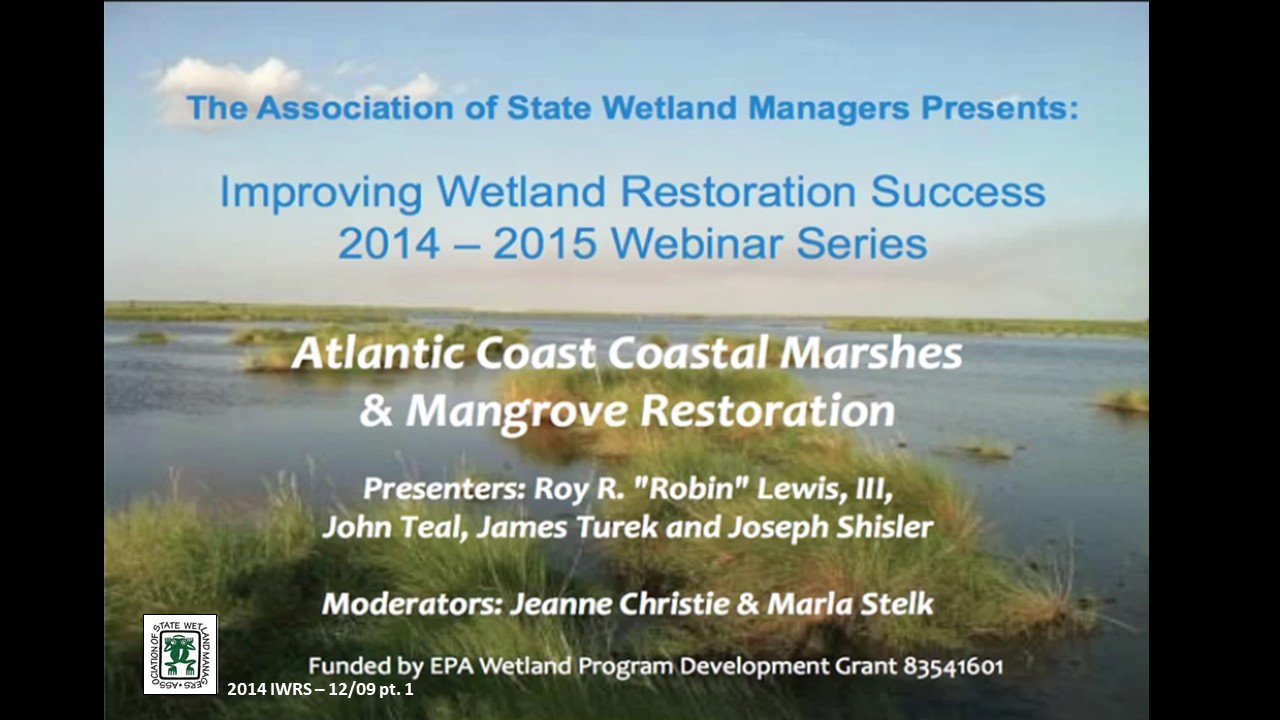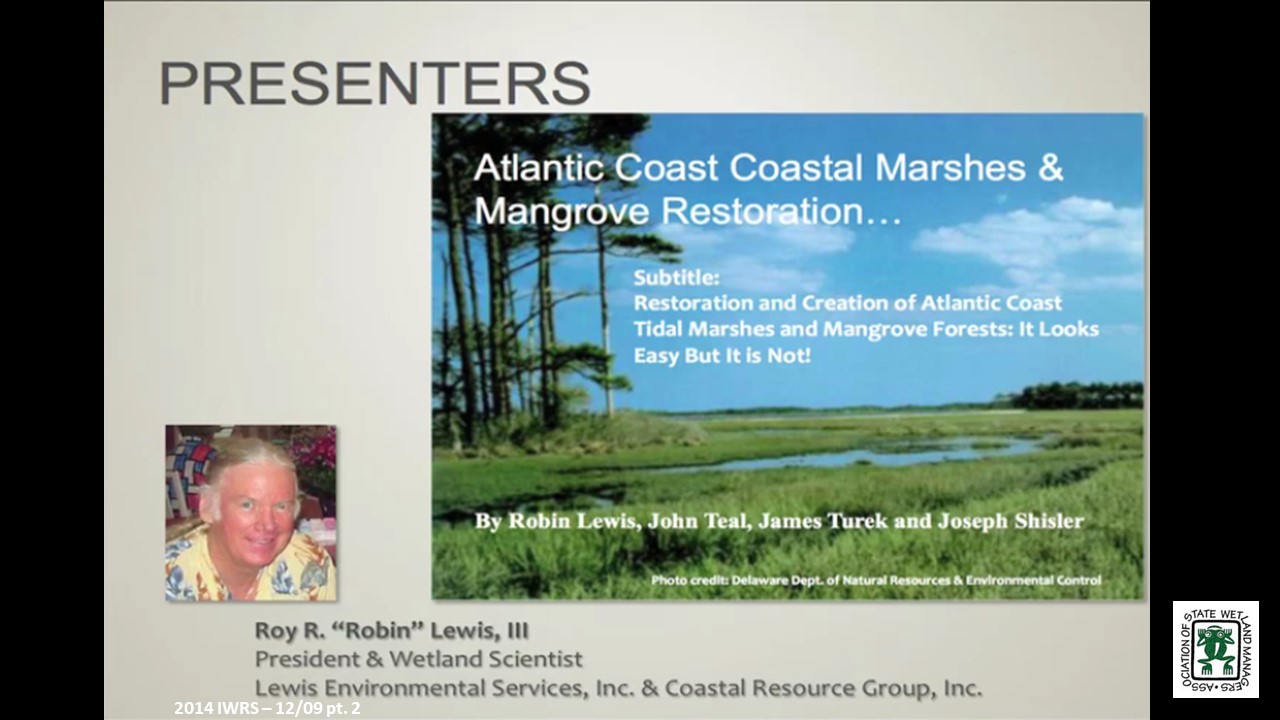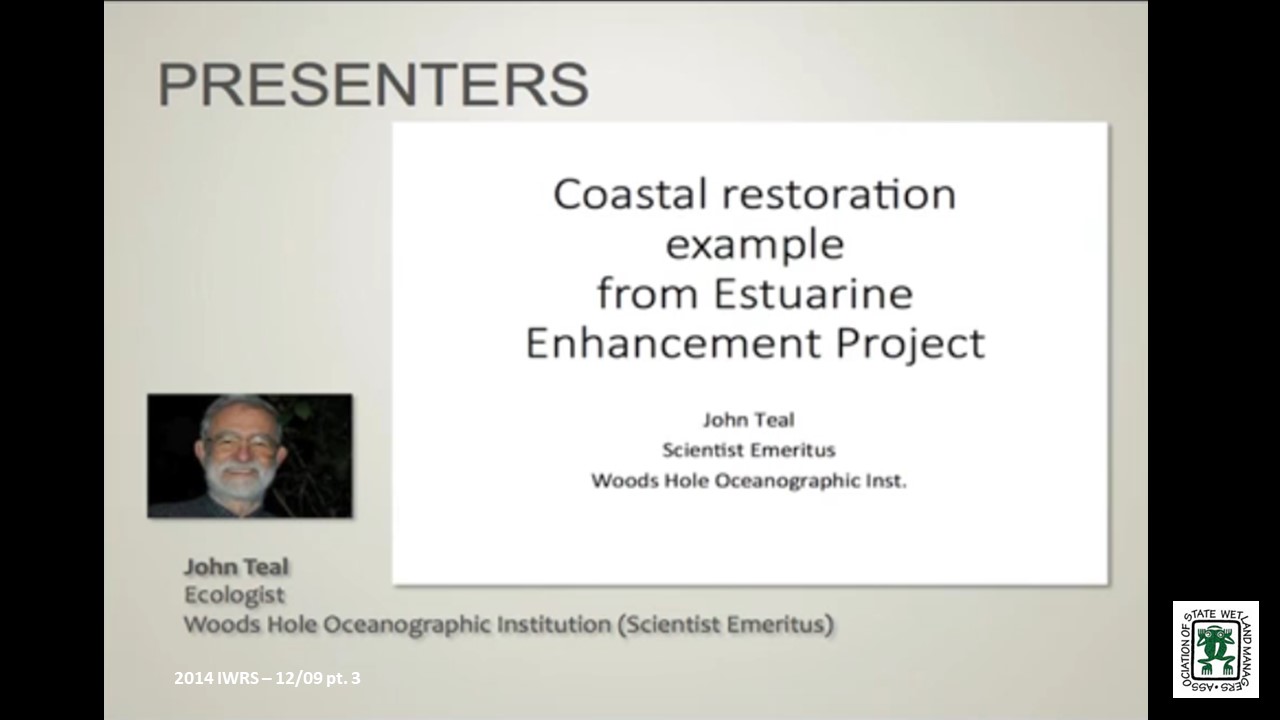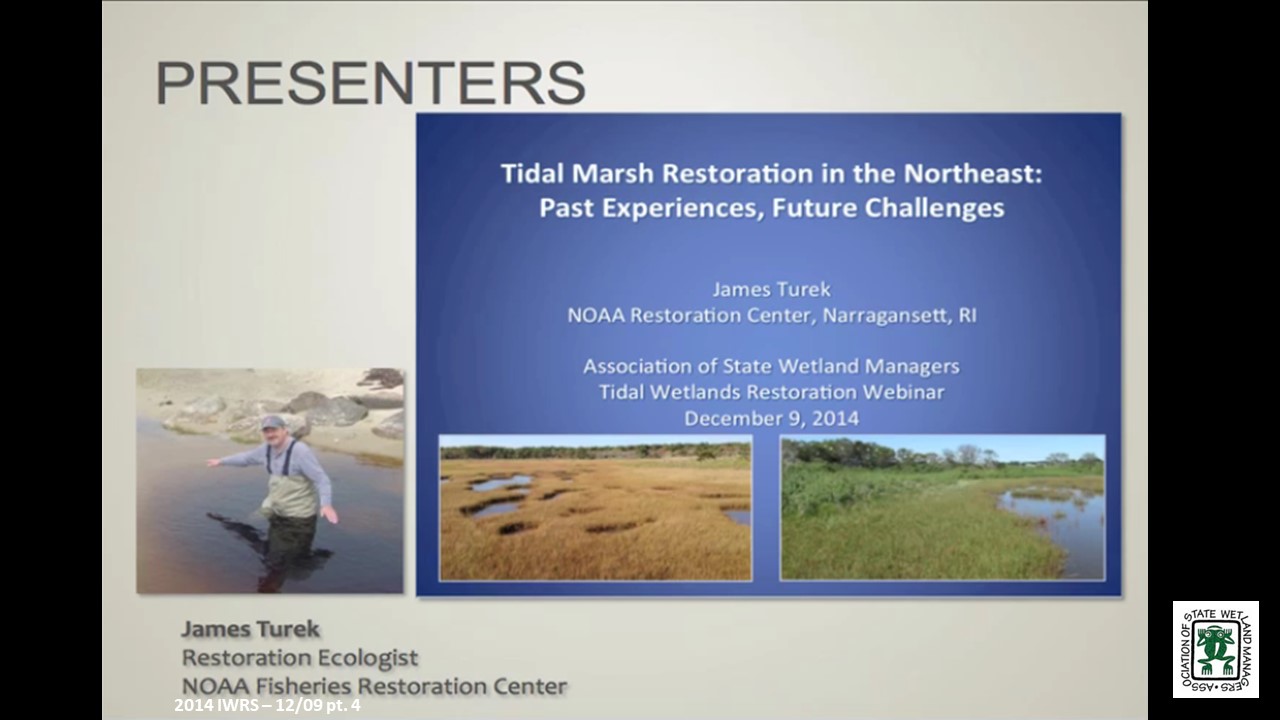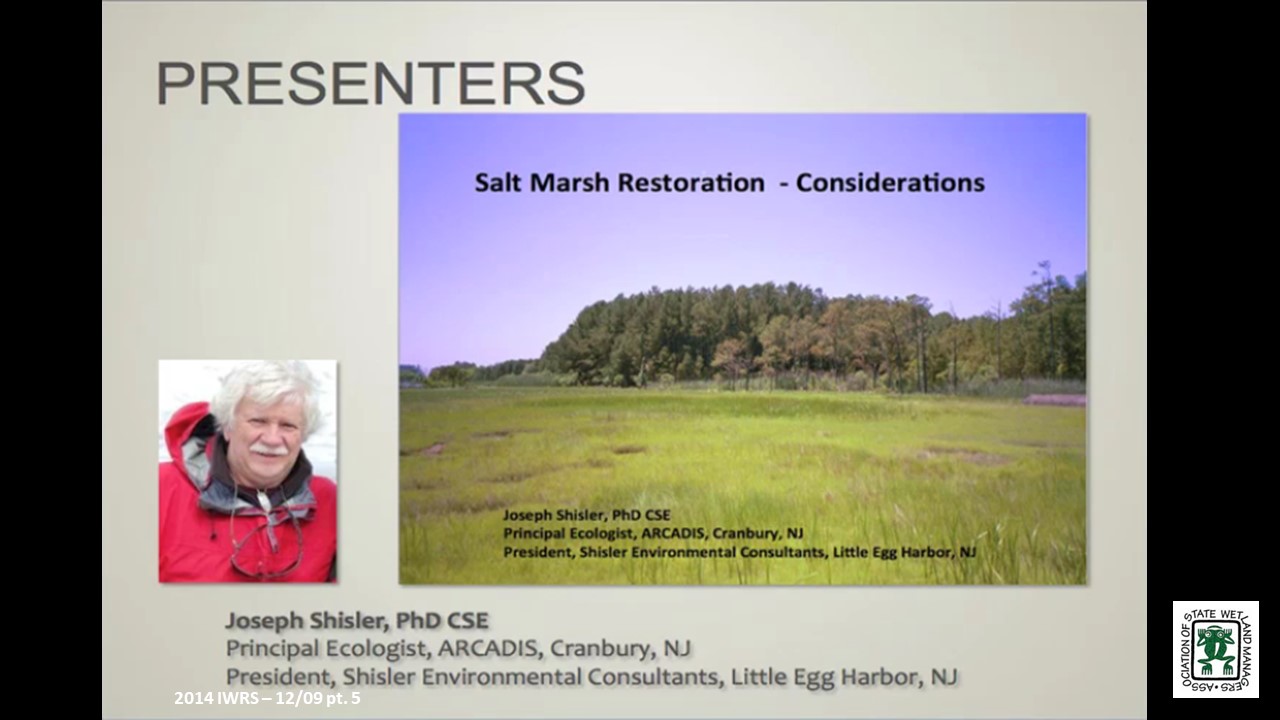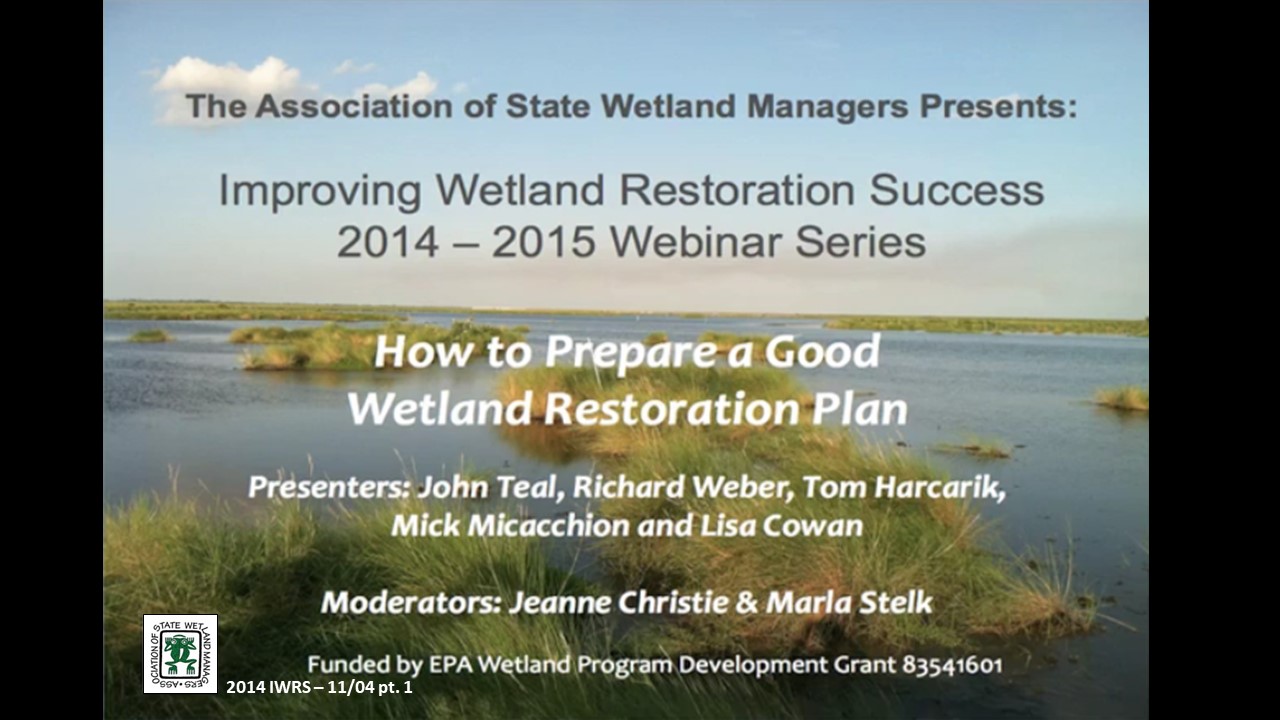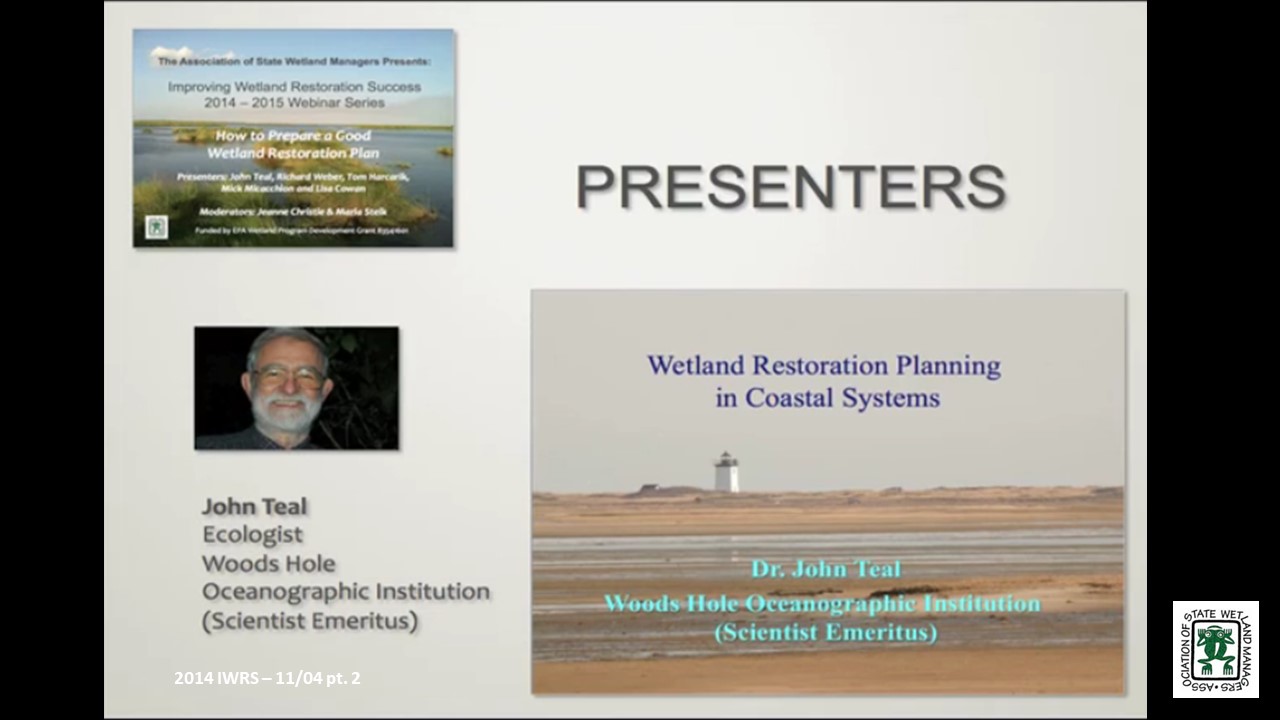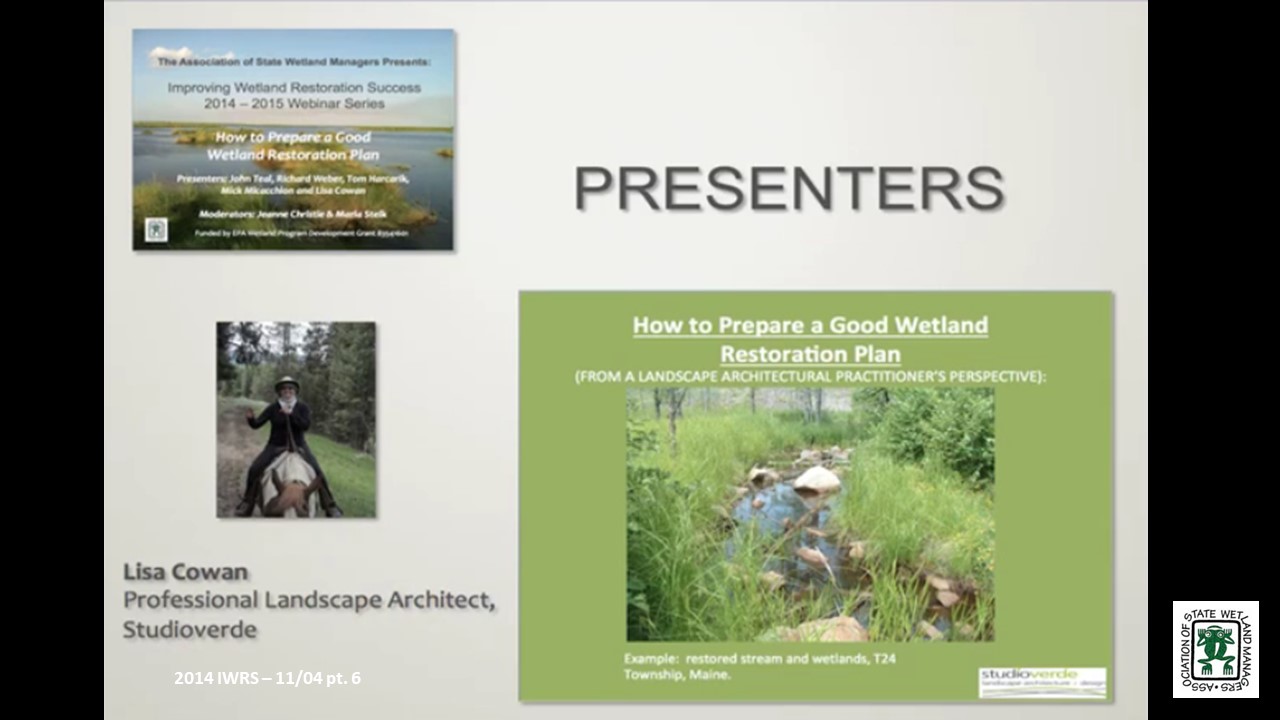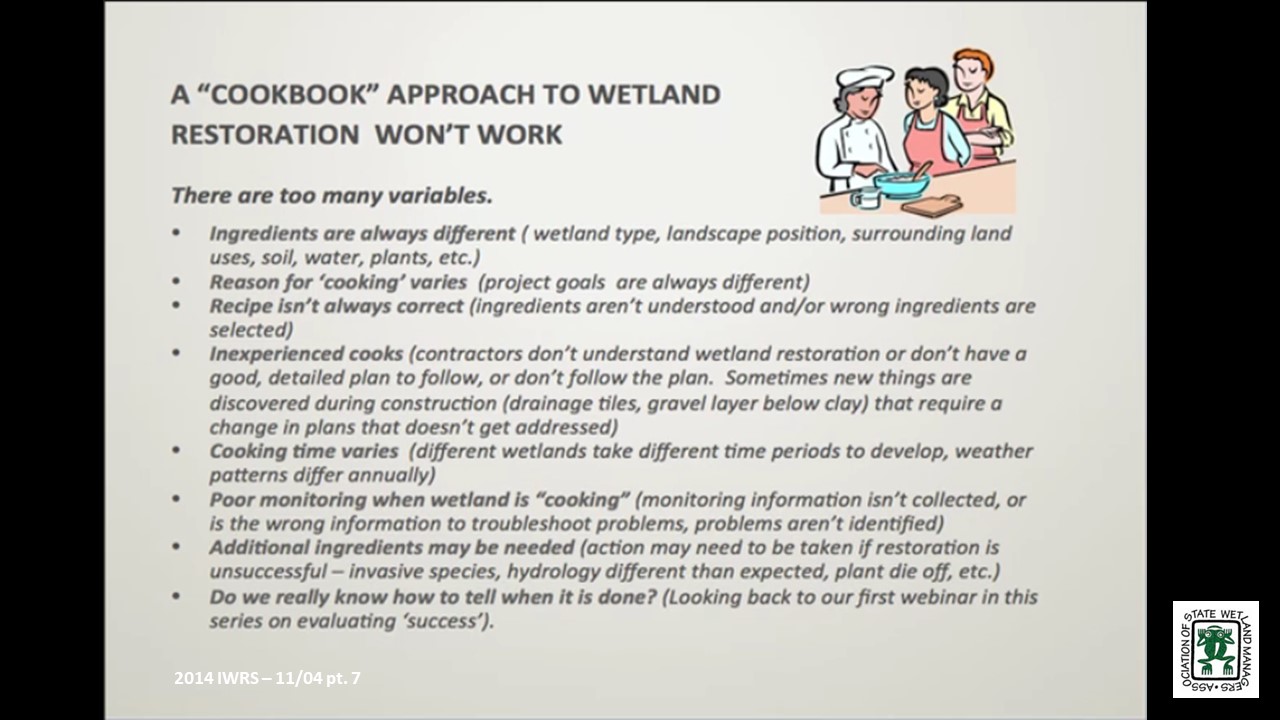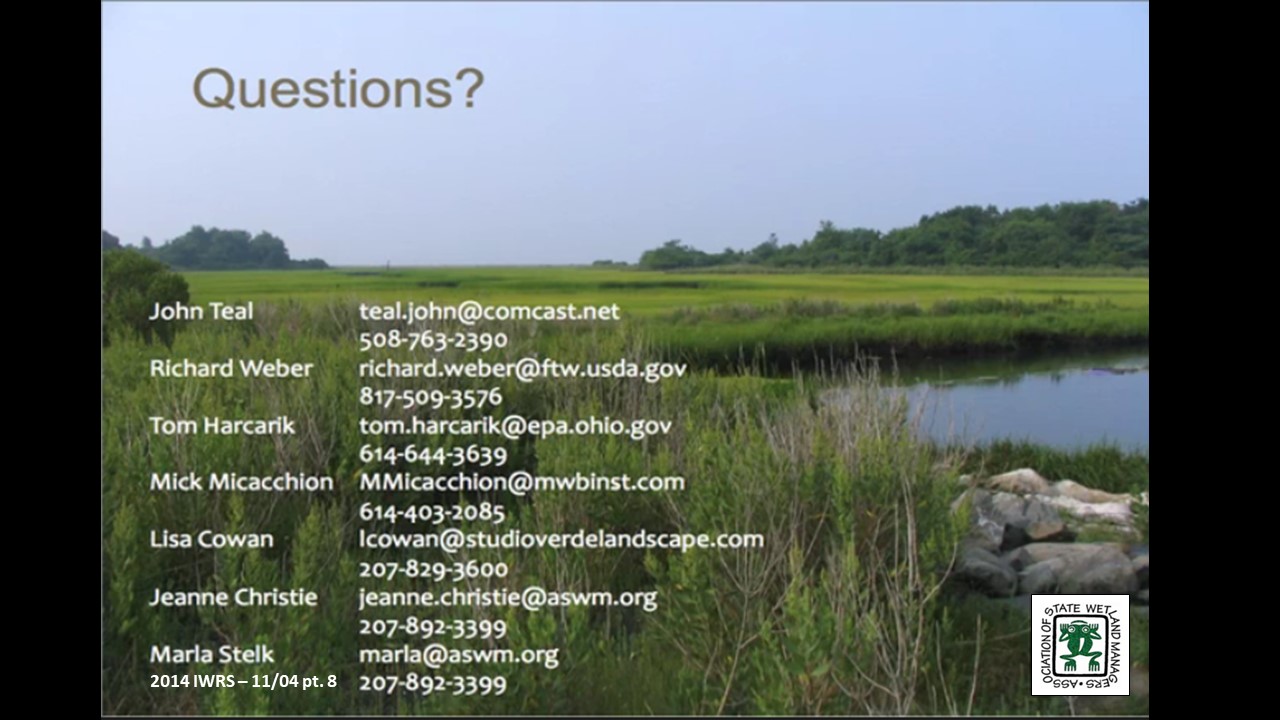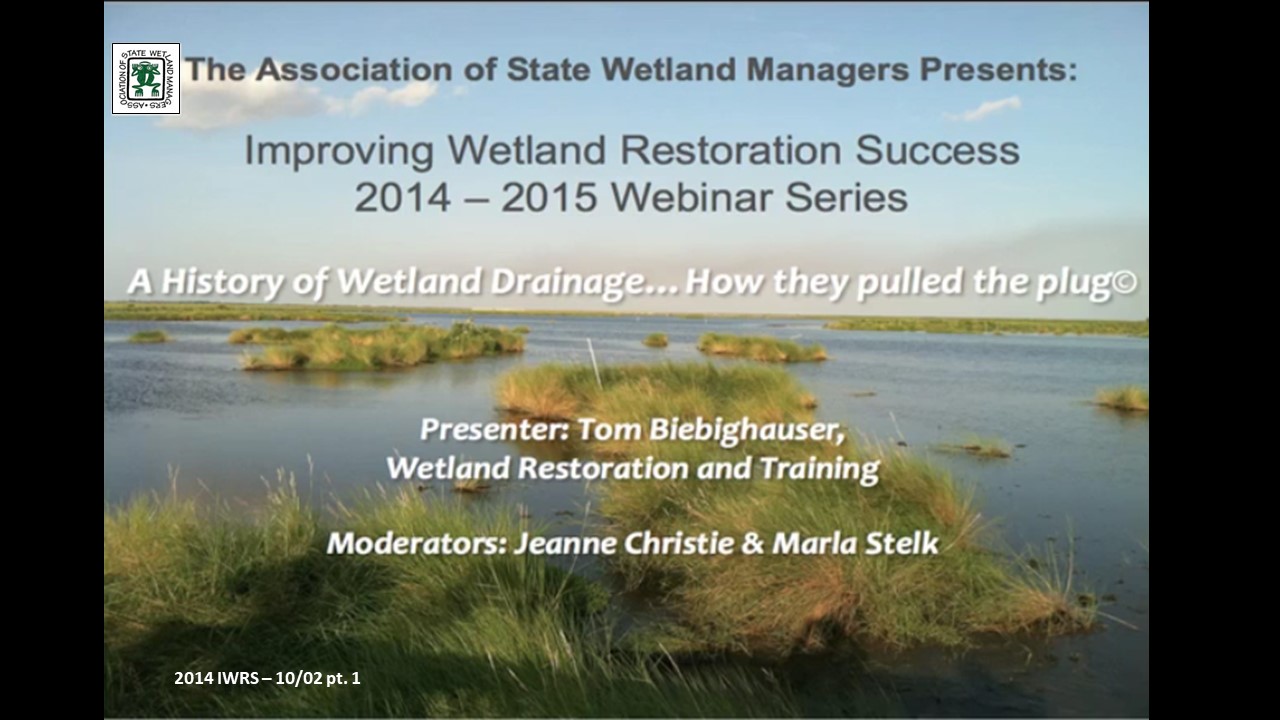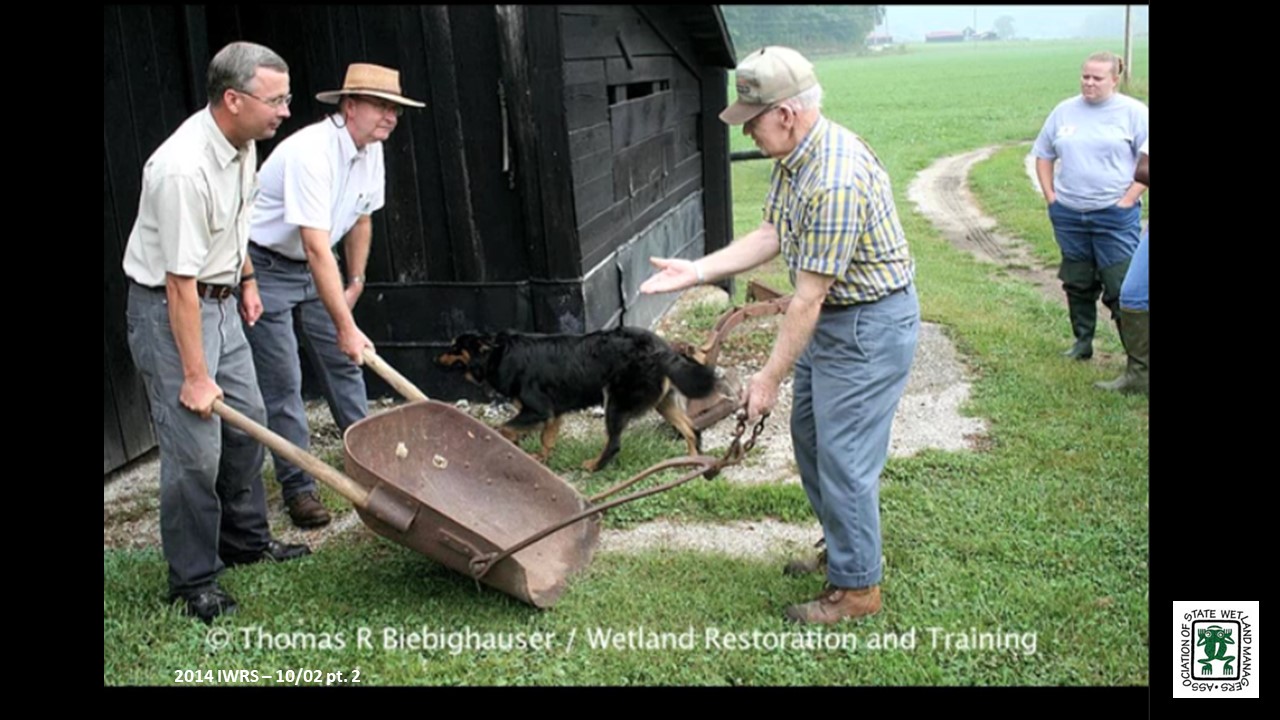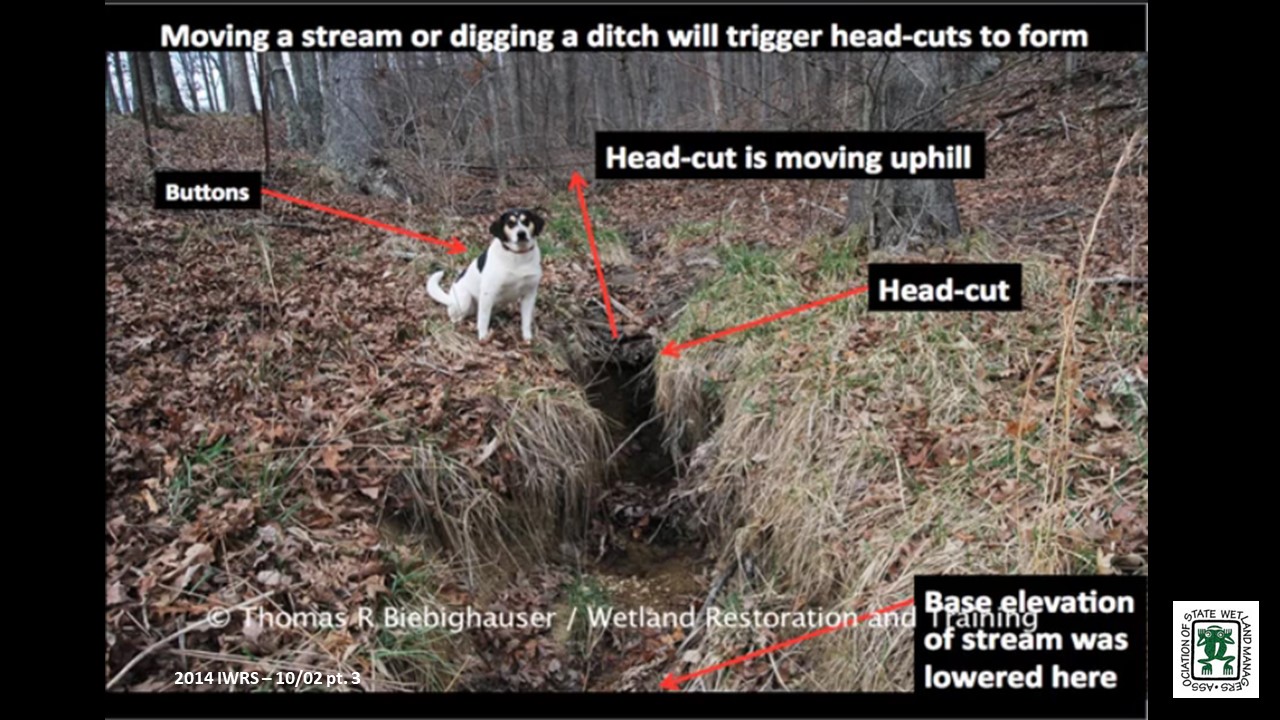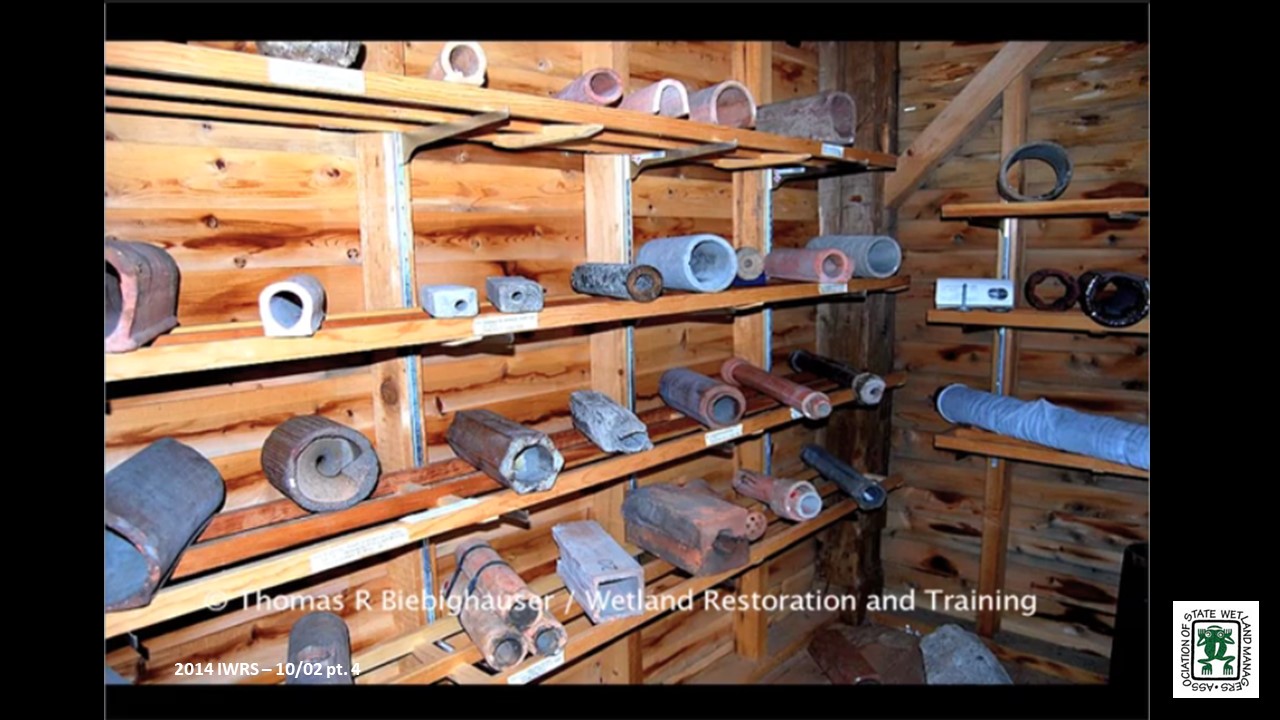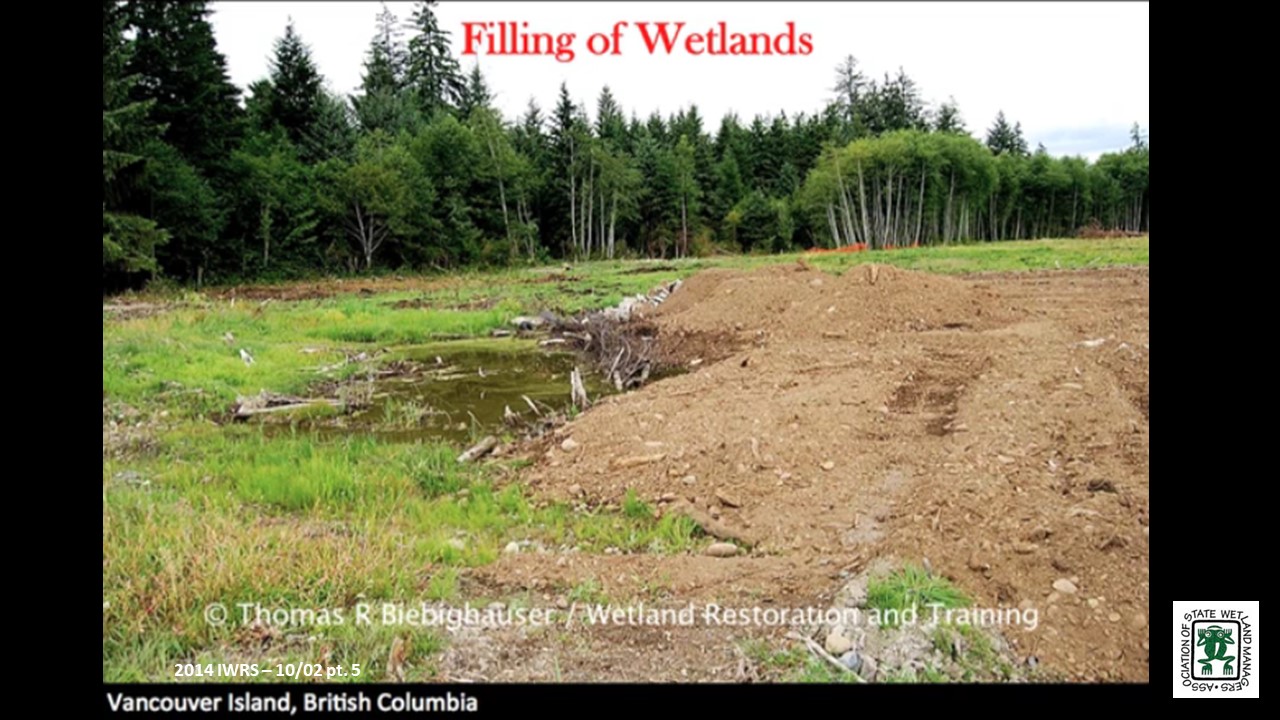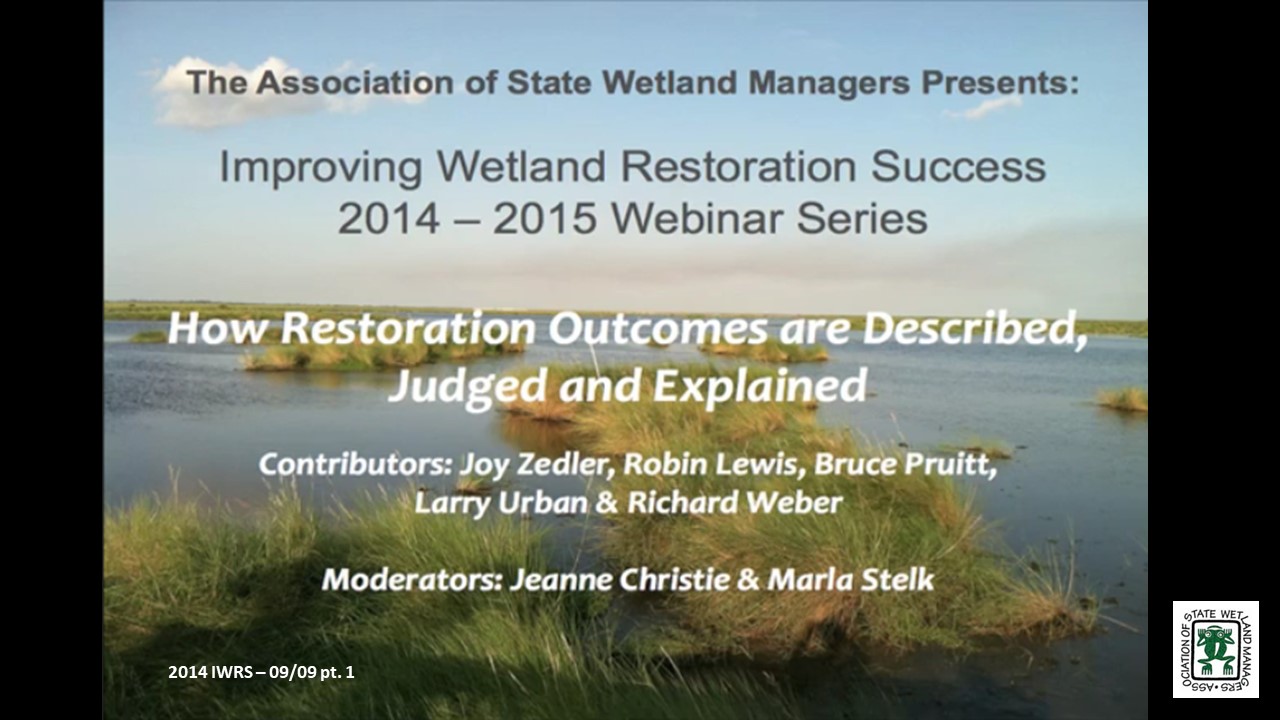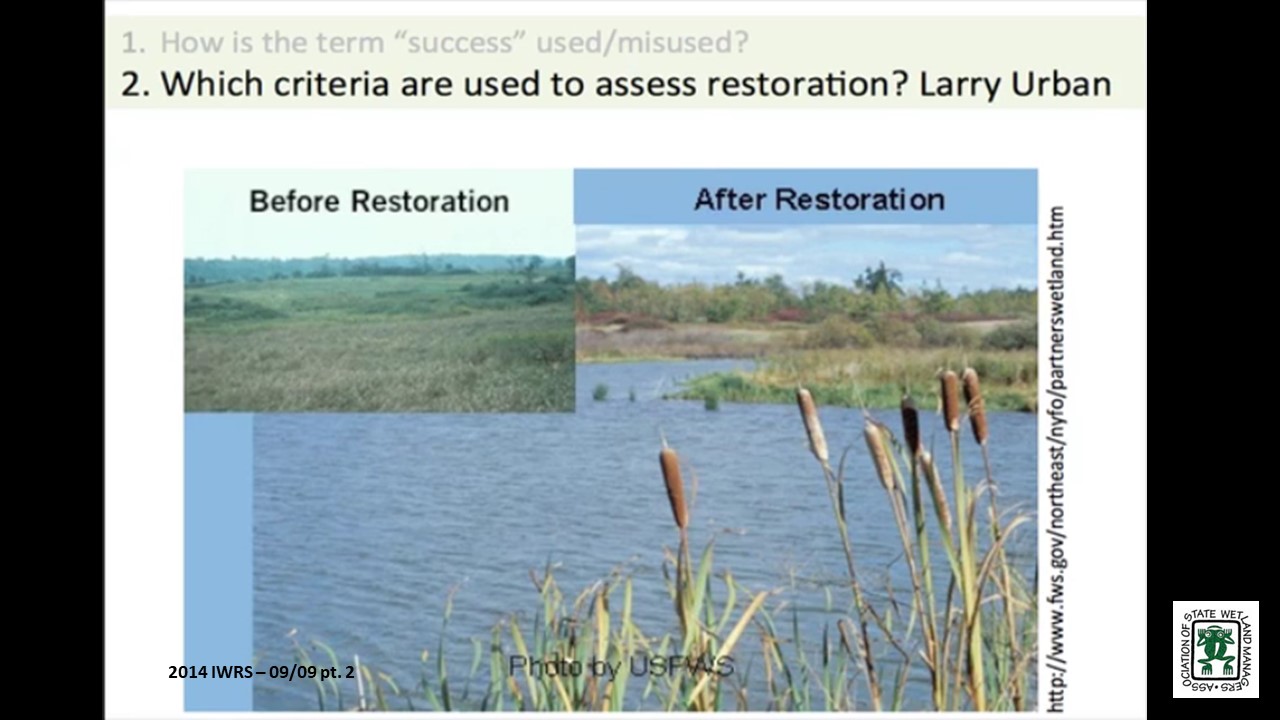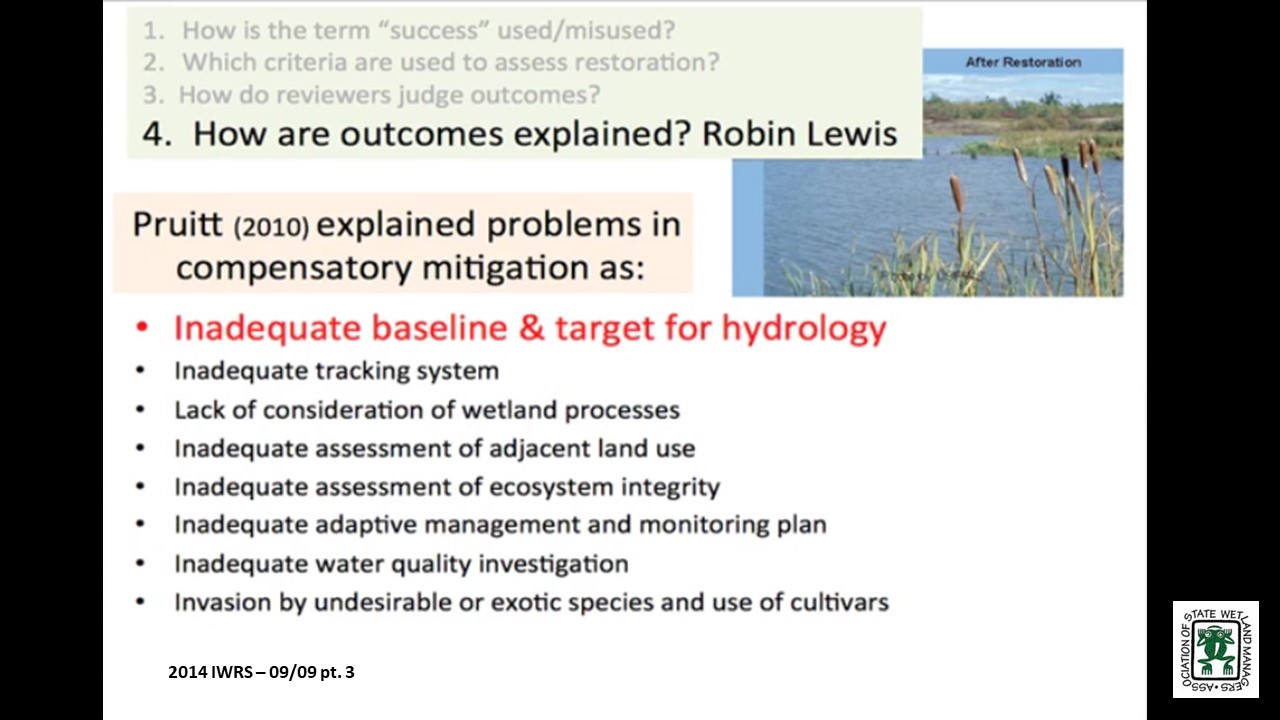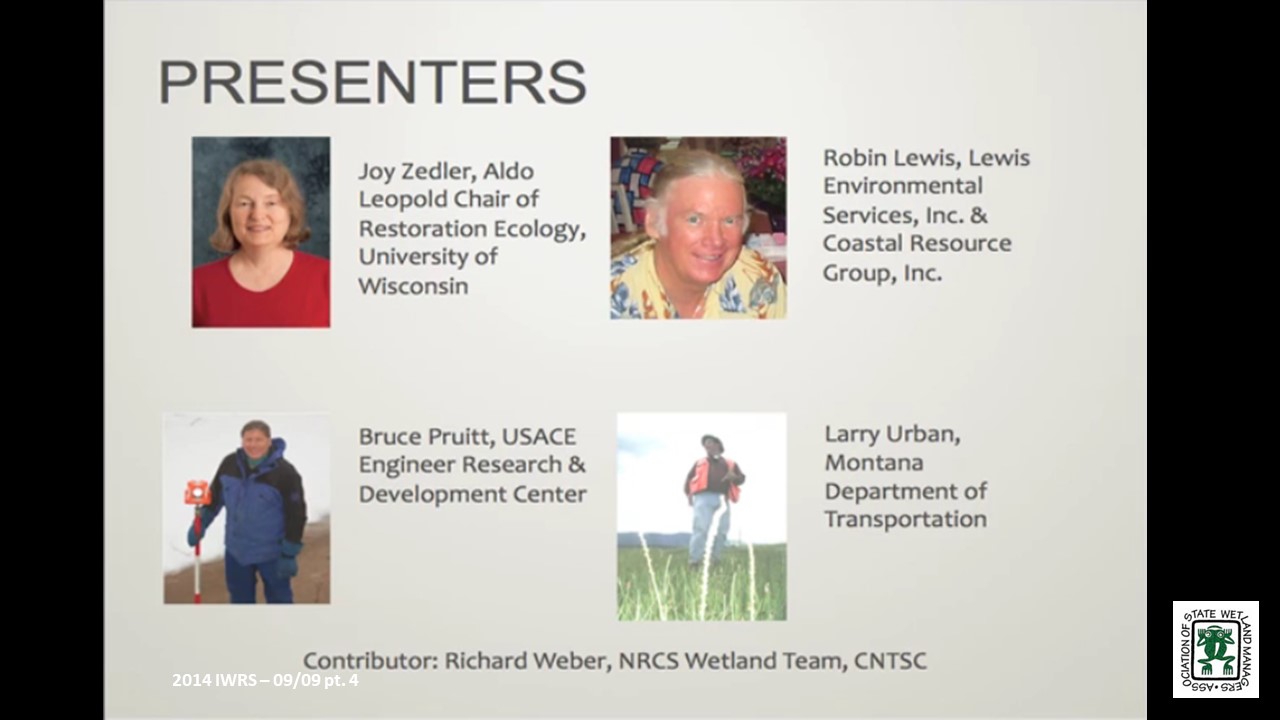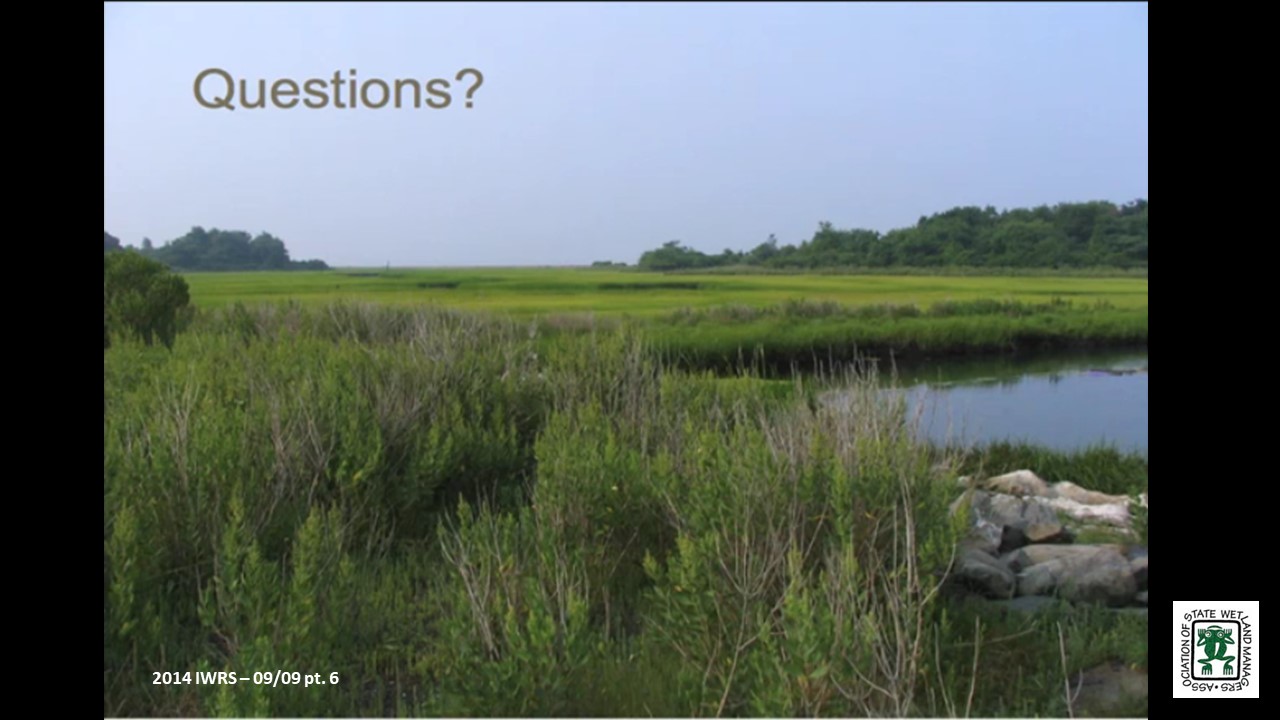Atlantic Coast Coastal Marshes and Mangrove Restoration
Held December 9, 2014 – 3:00 pm eastern![]()
INTRODUCTION
- Marla Stelk, Policy Analyst, Association of State Wetland Managers [POWERPOINT PRESENTATION]
PRESENTERS
- Robin Lewis, Lewis Environmental Services, Inc. & Coastal Resource Group, Inc.
- John Teal, Woods Hole Oceanographic Institution (Scientist Emeritus)
- Joseph Shisler, ARCADIS
- Jim Turek, NOAA Fisheries Restoration Center
PowerPoint presentation is available here.
Subtitle: Restoration and Creation of Atlantic Coast Tidal Marshes and Mangrove Forests: It Looks Easy But It is Not
ABSTRACT
Intertidal plant communities along the U.S. Atlantic coasts include a diverse set of tidal wetlands including regularly flooded emergent salt and brackish marshes, tidal freshwater marshes and swamps, irregularly flooded marsh and scrub-shrub wetlands, and mangrove forests in subtropical and tropical portions of Florida, and small areas in Louisiana and Texas.
These tidal wetland habitats contribute tremendous ecological and social benefits, such as: fish and invertebrate habitats; nesting and feeding areas for birds and other wildlife; exportation of plant material to detritus-based food webs; denitrification and carbon cycling; shoreline stabilization; and resiliency to storms and surge events. These resources have unfortunately undergone substantial losses due to land development practices such as dredging and fillingof these areas for nearly 400 years. Hydrologic restrictions and modifications in the form of diking, roadway and utility construction, ditching, and excessive groundwater withdrawals resulting in regional land subsidence have also taken their toll. Accelerating sea level rise, warming air and water temperatures, and more frequent and intense storm events associated with climate change collectively present ominous and challenging conditions for the future sustainability and functioning of Atlantic coastal wetlands.
Based upon historical reviews of the key elements in successfully restoring or creating thesecoastal wetland types, reason suggests that tidal wetlands should be more easily restored due to a predictable tidal cycle and hydrology. This condition is in contrast to freshwater marshes and forested wetlands, where the supporting hydrology is often less predictable, or submerged aquatic habitats including seagrasses, where water quality is a key limiting factor. In fact, in spite of multiple decades of attempts at restoration, and multiple guidance documents, many of these efforts fail.
The primary cause of these failures is the lack of understanding of the very limited range of tidal inundation that these plant communities can tolerate, and a tendency to see planting of marsh and mangrove vegetation as enough to solve this problem. It is not. Very careful attention to the hydrologic tolerances and requirements for each specific target plant species is essential, and in many cases, no planting of vegetation is necessary as volunteer plants can quickly establish with proximate seed sources and in properly designed and constructed restoration sites. Planting of vegetation may be a high priority or essential in some cases where seed banks are lacking and/or higher wave energy is expected, but plants alone may not control shore erosion where high fetch and certain landscape features prevail. Again, careful attention to the ability of plants alone to control coastal erosion is essential but often overlooked. The application of lessons learned from decades of efforts and documentation of both successes and failures is lacking. We provide guidance to the best methods and the literature sources to find out more about what works and what does not.
BIOS
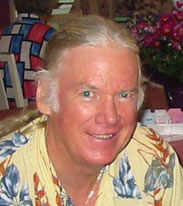 Roy R. "Robin" Lewis, III is President of Lewis Environmental Services, Inc., and Coastal Resources Group, Inc., a not-for-profit scientific and educational organization, both with offices in Valrico, Florida, and Salt Springs, Florida. He is a Professional Wetland Scientist certified by the Society of Wetland Scientists, certified Senior Ecologist with the Ecological Society of America and a member of the IUCN SSC Mangrove Specialist Group. He has forty years of experience in the design and construction of wetlands with over 200 completed and successful projects in the USA and overseas. He has recently designed, permitted, and supervised initial construction of a 400 ha mangrove restoration project at the Rookery Bay National Estuarine Research Reserve near Marco Island, and a 7,000 ha project in Indonesia. He has also worked and taught wetland restoration in twenty-two foreign countries including Jamaica, Bonaire, the Bahama Islands, Cuba, Costa Rica, Barbados, Guyana, Nigeria, Mexico, Puerto Rico, the US Virgin Islands, India, Sri Lanka, Thailand, Vietnam, Indonesia and Hong Kong. He specializes in the ecological monitoring, management and restoration of mangrove forests and seagrass meadows and has over 125 professional publications in these and other wetland subject areas.
Roy R. "Robin" Lewis, III is President of Lewis Environmental Services, Inc., and Coastal Resources Group, Inc., a not-for-profit scientific and educational organization, both with offices in Valrico, Florida, and Salt Springs, Florida. He is a Professional Wetland Scientist certified by the Society of Wetland Scientists, certified Senior Ecologist with the Ecological Society of America and a member of the IUCN SSC Mangrove Specialist Group. He has forty years of experience in the design and construction of wetlands with over 200 completed and successful projects in the USA and overseas. He has recently designed, permitted, and supervised initial construction of a 400 ha mangrove restoration project at the Rookery Bay National Estuarine Research Reserve near Marco Island, and a 7,000 ha project in Indonesia. He has also worked and taught wetland restoration in twenty-two foreign countries including Jamaica, Bonaire, the Bahama Islands, Cuba, Costa Rica, Barbados, Guyana, Nigeria, Mexico, Puerto Rico, the US Virgin Islands, India, Sri Lanka, Thailand, Vietnam, Indonesia and Hong Kong. He specializes in the ecological monitoring, management and restoration of mangrove forests and seagrass meadows and has over 125 professional publications in these and other wetland subject areas.
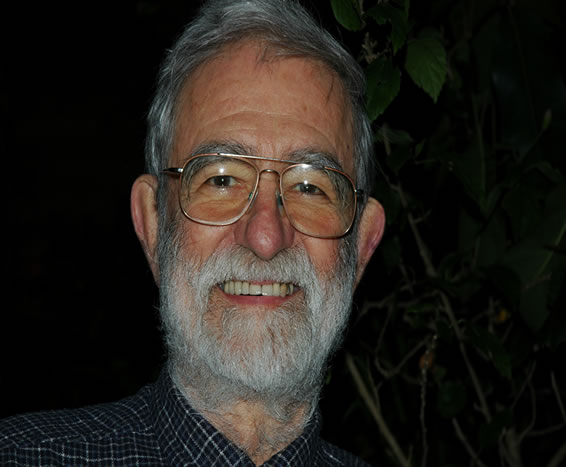 John Teal's professional career began in the early 1950’s with his Harvard Ph.D. thesis on the trophic relationships in a tiny cold spring in Massachusetts. He then studied salt marshes at University of Georgia Marine Institute at Sapelo Island. After four years, he went to Dalhousie University in Halifax at the new oceanography establishment in eastern Canada. Dr.Teal joined Woods Hole Oceanographic Institution in 1961 and has been Scientist Emeritus since 1995. In addition to research on coastal wetlands he has worked on physiology of large, warm blooded fishes, bird migration over the oceans, oil pollution, and wastewater treatment by wetlands. He has been involved since 1993 in a salt marsh restoration project in Delaware Bay that encompasses 32 square miles. He served on the Louisiana Coastal Area (LCA) scientific advisory committee for the Mississippi delta. Dr. Teal has served on National Academy committees, Federal advisory committees, editorial boards of scientific journals, published in both the scientific and popular literature, and served on local committees. Always interested in the willingness and/or unwillingness of professional scientists to take part in public policy decisions, Dr. Teal has served on the board of the Conservation Law Foundation of New England since 1978 and is now Trustee Emeritus. He was president of the Society of Wetland Scientists in 1998-9.
John Teal's professional career began in the early 1950’s with his Harvard Ph.D. thesis on the trophic relationships in a tiny cold spring in Massachusetts. He then studied salt marshes at University of Georgia Marine Institute at Sapelo Island. After four years, he went to Dalhousie University in Halifax at the new oceanography establishment in eastern Canada. Dr.Teal joined Woods Hole Oceanographic Institution in 1961 and has been Scientist Emeritus since 1995. In addition to research on coastal wetlands he has worked on physiology of large, warm blooded fishes, bird migration over the oceans, oil pollution, and wastewater treatment by wetlands. He has been involved since 1993 in a salt marsh restoration project in Delaware Bay that encompasses 32 square miles. He served on the Louisiana Coastal Area (LCA) scientific advisory committee for the Mississippi delta. Dr. Teal has served on National Academy committees, Federal advisory committees, editorial boards of scientific journals, published in both the scientific and popular literature, and served on local committees. Always interested in the willingness and/or unwillingness of professional scientists to take part in public policy decisions, Dr. Teal has served on the board of the Conservation Law Foundation of New England since 1978 and is now Trustee Emeritus. He was president of the Society of Wetland Scientists in 1998-9.
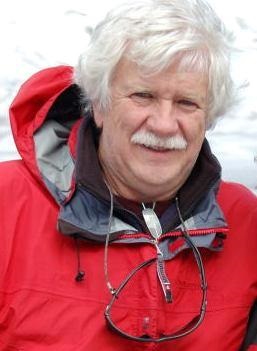 Joseph Shisler is a Principal Ecologist at ARCADIS in Cranbury, NJ. A nationally recognized wetlands expert, he received is PhD from Rutgers University in 1975 where he studied in the impacts of alterations to salt marshes. He was at Rutgers University for more than 10 years directing research on wetlands, wildlife use, stormwater management, wetland mitigation, and coastal zone management issues. He has more than 42 years of experience conducting wetland evaluations and restoration projects and has served as a consultant to various state, federal, and international agencies concerning these issues. The New Jersey Wildlife Society recognized his work and presented him with the 1980 Conservationist of the Year award. Governor Kean appointed him chairperson of the New Jersey Wetlands Mitigation Council in 1989 for which he served for 9 years. He has been a consultant for over 20 years in a salt marsh restoration project in Delaware Bay that encompasses 32 square miles. He is a certified Senior Ecologist by the Ecological Society of America and has over 100 professional publications and presentations on wetland subjects.
Joseph Shisler is a Principal Ecologist at ARCADIS in Cranbury, NJ. A nationally recognized wetlands expert, he received is PhD from Rutgers University in 1975 where he studied in the impacts of alterations to salt marshes. He was at Rutgers University for more than 10 years directing research on wetlands, wildlife use, stormwater management, wetland mitigation, and coastal zone management issues. He has more than 42 years of experience conducting wetland evaluations and restoration projects and has served as a consultant to various state, federal, and international agencies concerning these issues. The New Jersey Wildlife Society recognized his work and presented him with the 1980 Conservationist of the Year award. Governor Kean appointed him chairperson of the New Jersey Wetlands Mitigation Council in 1989 for which he served for 9 years. He has been a consultant for over 20 years in a salt marsh restoration project in Delaware Bay that encompasses 32 square miles. He is a certified Senior Ecologist by the Ecological Society of America and has over 100 professional publications and presentations on wetland subjects.
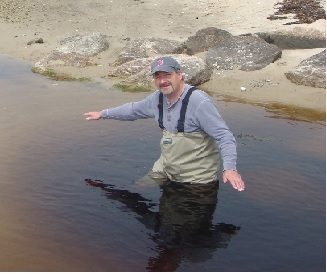 James Turek is a restoration ecologist with the NOAA Fisheries Restoration Center (RC) stationed at the Northeast Fisheries Science Center Lab in Narragansett, RI. Jim has worked with the RC for more than 15 years, managing or providing technical assistance on a variety of coastal habitat restoration projects primarily in Narragansett Bay, Long Island Sound, Buzzards Bay and their watersheds. Much of his work is carried out through NOAA’s Community-Based Restoration Program (CRP) and the Damage Assessment, Remediation and Restoration Program (DARRP) to restore natural resource damage injuries resulting from oil spills and other contaminant releases. His expertise includes planning, designing, cost estimating, implementing and monitoring tidal marsh and freshwater wetland restorations, and dam removals, nature-like fishways and other river barrier removal projects leading to diadromous fish passage and population restoration. Prior to joining the RC, Mr. Turek worked as an environmental consultant for 13 years with firms in Maryland and Rhode Island, where he led or participated in more than 450 wetland delineations, planning studies, impact assessments, and wetland mitigation projects. He also spent 3 years as a fishery biologist at the former NOAA Fisheries Lab in Oxford, Maryland, where his work included evaluating Chesapeake Bay tidal marsh restoration performance. Jim holds a Bachelor’s Degree in Zoology and minor in Geological Sciences from the University of Maine at Orono, and a Master’s Degree in Marine Affairs from the University of Rhode Island.
James Turek is a restoration ecologist with the NOAA Fisheries Restoration Center (RC) stationed at the Northeast Fisheries Science Center Lab in Narragansett, RI. Jim has worked with the RC for more than 15 years, managing or providing technical assistance on a variety of coastal habitat restoration projects primarily in Narragansett Bay, Long Island Sound, Buzzards Bay and their watersheds. Much of his work is carried out through NOAA’s Community-Based Restoration Program (CRP) and the Damage Assessment, Remediation and Restoration Program (DARRP) to restore natural resource damage injuries resulting from oil spills and other contaminant releases. His expertise includes planning, designing, cost estimating, implementing and monitoring tidal marsh and freshwater wetland restorations, and dam removals, nature-like fishways and other river barrier removal projects leading to diadromous fish passage and population restoration. Prior to joining the RC, Mr. Turek worked as an environmental consultant for 13 years with firms in Maryland and Rhode Island, where he led or participated in more than 450 wetland delineations, planning studies, impact assessments, and wetland mitigation projects. He also spent 3 years as a fishery biologist at the former NOAA Fisheries Lab in Oxford, Maryland, where his work included evaluating Chesapeake Bay tidal marsh restoration performance. Jim holds a Bachelor’s Degree in Zoology and minor in Geological Sciences from the University of Maine at Orono, and a Master’s Degree in Marine Affairs from the University of Rhode Island.
![]()
How to Prepare a Good Wetland Restoration Plan
Held November 4, 2014 – 3:00 pm eastern
INTRODUCTION
- Marla Stelk, Policy Analyst, Association of State Wetland Managers [POWERPOINT PRESENTATION]
PRESENTERS
- Richard Weber, NRCS Wetland Team, CNTSC
- Tom Harcarik, Ohio EPA, Division of Environmental & Financial Assistance
- john Teal, Woods Hole Oceanographic Institution (Scientist Emeritus)
- Lisa Cowan, Professional Landscape Architect, Studioverde
- Mick Micacchion, Midwest Biodiversity Institute
PowerPoint presentation is available here.
ABSTRACT
Wetland Restoration projects often provide less than desirable results. The reasons for this are many and varied. However, the opportunity for success is greatly increased by following basic planning procedures. In all cases, planning requires an inventory of the hydrologic and landscape inputs to the project. Also required is a clear set of objectives that takes these inputs into account. Planning includes the efforts needed for public participation, permitting, design of restoration elements, construction contracting and management, and post implementation monitoring, maintenance and management. Restoration projects vary widely between landscapes. They also vary widely by objectives that include ecosystem restoration, non-point source pollution treatment, waterfowl habitat, flood attenuation, etc. However, all wetlands rest on a soil substrate, and have a water budget that includes dominant water sources. All also support unique plant communities that interact with soil, water, and watershed inputs to provide wetland functions. Project planning provides the inventory, analysis, and objective setting needed to implement projects that make use of these parameters.
BIOS
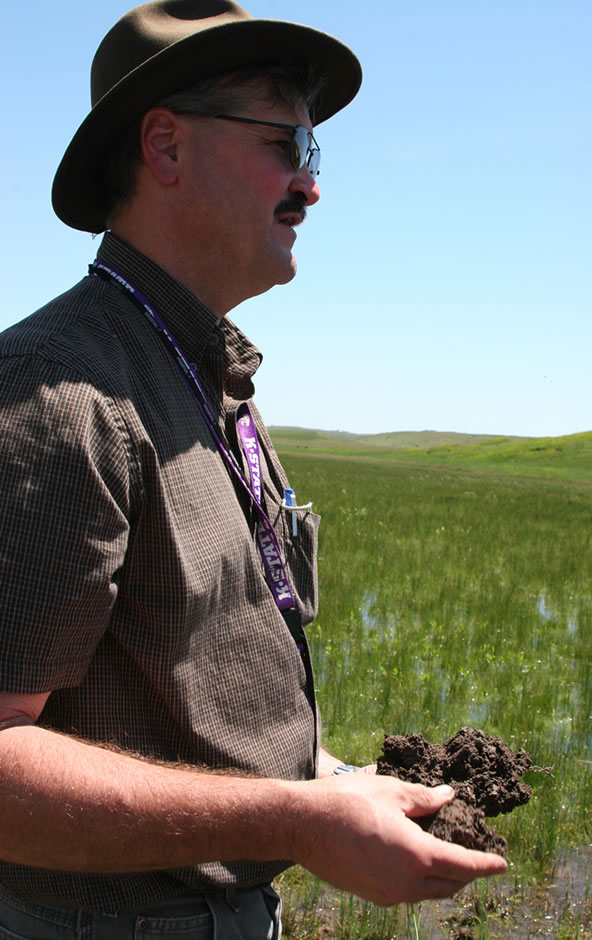 Richard A. Weber is a Wetland Hydraulic Engineer with the USDA Natural Resources Conservation Service (NRCS), Wetland Team, CNTSC in Fort Worth, Texas from 2006 to present. In this role, Rich has provided national leadership on wetland hydrology, including: Support for Wetland Restoration Program, Wetland Protection Policy, and E.O. 11990 Wetland Assessments. He leads a national training cadre for Wetland Restoration and Enhancement and Hydrology Tools for Wetland Determination courses. From 2005-2006, Rich was Design Engineer at the NRCS Nebraska State Office where he had design and A&E Contracting responsibilities for PL-566, WRP, and EQIP programs. From 1999-2005, he was a Field Engineer at the NRCS in the Scottsbluff, NE Field Office where he had design, construction, and contracting responsibilities for the Wetland Reserve Program, EQIP Irrigation and Animal Waste Management, and CTA conservation practices. From 1997-1999, Rich was an Agricultural Engineer at the NRCS in Chehalis, WA where he had design, construction, and contracting responsibilities for Conservation District funded Stream Restoration and Fish Passage projects, and EQIP program Animal Waste Projects. And from 1986-1997, he was a Watershed Project Engineer at the NRCS in Horton, KS where he performed Construction Contract Administration for PL-566 Watershed Protection and Flood Prevention projects.
Richard A. Weber is a Wetland Hydraulic Engineer with the USDA Natural Resources Conservation Service (NRCS), Wetland Team, CNTSC in Fort Worth, Texas from 2006 to present. In this role, Rich has provided national leadership on wetland hydrology, including: Support for Wetland Restoration Program, Wetland Protection Policy, and E.O. 11990 Wetland Assessments. He leads a national training cadre for Wetland Restoration and Enhancement and Hydrology Tools for Wetland Determination courses. From 2005-2006, Rich was Design Engineer at the NRCS Nebraska State Office where he had design and A&E Contracting responsibilities for PL-566, WRP, and EQIP programs. From 1999-2005, he was a Field Engineer at the NRCS in the Scottsbluff, NE Field Office where he had design, construction, and contracting responsibilities for the Wetland Reserve Program, EQIP Irrigation and Animal Waste Management, and CTA conservation practices. From 1997-1999, Rich was an Agricultural Engineer at the NRCS in Chehalis, WA where he had design, construction, and contracting responsibilities for Conservation District funded Stream Restoration and Fish Passage projects, and EQIP program Animal Waste Projects. And from 1986-1997, he was a Watershed Project Engineer at the NRCS in Horton, KS where he performed Construction Contract Administration for PL-566 Watershed Protection and Flood Prevention projects.
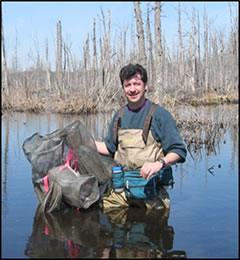 Tom Harcarik is an environmental planner with Ohio EPA’s Division of Environmental and Financial Assistance where he reviews water and wastewater infrastructure projects seeking financing under the State Revolving Fund (SRF) programs. Tom evaluates environmental impacts, including floodplains, threatened and endangered species, historic properties, and streams and wetlands, under the NEPA-like State Environmental Review Process. He also evaluates stream and wetland restoration and protection projects seeking funding through Ohio EPA’s Water Resource Restoration Sponsor Program. Tom also assists the Ohio Power Siting Board by evaluating impacts to aquatic resources resulting from proposed power plants, transmission lines, and wind power projects.
Tom Harcarik is an environmental planner with Ohio EPA’s Division of Environmental and Financial Assistance where he reviews water and wastewater infrastructure projects seeking financing under the State Revolving Fund (SRF) programs. Tom evaluates environmental impacts, including floodplains, threatened and endangered species, historic properties, and streams and wetlands, under the NEPA-like State Environmental Review Process. He also evaluates stream and wetland restoration and protection projects seeking funding through Ohio EPA’s Water Resource Restoration Sponsor Program. Tom also assists the Ohio Power Siting Board by evaluating impacts to aquatic resources resulting from proposed power plants, transmission lines, and wind power projects.
Tom started his career at Ohio EPA as a summer intern where he was a “bug picker” and “fish kicker.” Tom has since worked for Ohio EPA for over 29 years, including 17 years in the 401 Water Quality Certification program and Wetland Ecology Group. Additionally, Tom has worked in the enforcement sections for Ohio EPA’s solid waste and unregulated hazardous waste programs, where he reviewed cases and served as a liaison to the Attorney General’s Office. Tom received his Bachelors of Science in Conservation, with an area of specialization in aquatic ecology, from Kent State University. Tom is an avid backpacker, and lives by the motto, “A bad day in the field always beats a good day in the office!”
 John Teal's professional career began in the early 1950’s with his Harvard Ph.D. thesis on the trophic relationships in a tiny cold spring in Massachusetts. He then studied salt marshes at University of Georgia Marine Institute at Sapelo Island. After four years, he went to Dalhousie University in Halifax at the new oceanography establishment in eastern Canada. Dr.Teal joined Woods Hole Oceanographic Institution in 1961 and has been Scientist Emeritus since 1995. In addition to research on coastal wetlands he has worked on physiology of large, warm blooded fishes, bird migration over the oceans, oil pollution, and wastewater treatment by wetlands. He has been involved since 1993 in a salt marsh restoration project in Delaware Bay that encompasses 32 square miles. He served on the Louisiana Coastal Area (LCA) scientific advisory committee for the Mississippi delta. Dr. Teal has served on National Academy committees, Federal advisory committees, editorial boards of scientific journals, published in both the scientific and popular literature, and served on local committees. Always interested in the willingness and/or unwillingness of professional scientists to take part in public policy decisions, Dr. Teal has served on the board of the Conservation Law Foundation of New England since 1978 and is now Trustee Emeritus. He was president of the Society of Wetland Scientists in 1998-9.
John Teal's professional career began in the early 1950’s with his Harvard Ph.D. thesis on the trophic relationships in a tiny cold spring in Massachusetts. He then studied salt marshes at University of Georgia Marine Institute at Sapelo Island. After four years, he went to Dalhousie University in Halifax at the new oceanography establishment in eastern Canada. Dr.Teal joined Woods Hole Oceanographic Institution in 1961 and has been Scientist Emeritus since 1995. In addition to research on coastal wetlands he has worked on physiology of large, warm blooded fishes, bird migration over the oceans, oil pollution, and wastewater treatment by wetlands. He has been involved since 1993 in a salt marsh restoration project in Delaware Bay that encompasses 32 square miles. He served on the Louisiana Coastal Area (LCA) scientific advisory committee for the Mississippi delta. Dr. Teal has served on National Academy committees, Federal advisory committees, editorial boards of scientific journals, published in both the scientific and popular literature, and served on local committees. Always interested in the willingness and/or unwillingness of professional scientists to take part in public policy decisions, Dr. Teal has served on the board of the Conservation Law Foundation of New England since 1978 and is now Trustee Emeritus. He was president of the Society of Wetland Scientists in 1998-9.
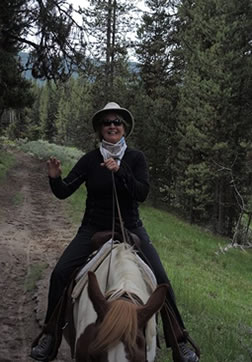 Lisa Cowan is Principal at Studioverde - a collaborative of landscape architects and practitioners in the fields of resource economics, ecology, horticulture and public art, working together to create high performance landscapes. Lisa’s work exemplifies a lifelong interest in the restoration of natural systems and community engagement in the natural world. She has expertise in ecology-based planning, design, low impact construction and land management and was the lead landscape architect on over thirty successful wetland and riparian creation and restoration projects. Lisa is a Co-Chair of the American Society of Landscape Architect’s Sustainable Design and Development (SDD) Professional Practice group and is the editor for the SDD blog for the Field. Lisa has also been active in public outreach and education on the Sustainable Sites Initiative rating system (SITES) since 2009. Lisa will be teaming with Marla Stelk, ASWM on a talk about the status of wetland restoration and role of landscape architects as an integrated team member at the ASLA 2014 Annual conference in Denver, Colorado this November.
Lisa Cowan is Principal at Studioverde - a collaborative of landscape architects and practitioners in the fields of resource economics, ecology, horticulture and public art, working together to create high performance landscapes. Lisa’s work exemplifies a lifelong interest in the restoration of natural systems and community engagement in the natural world. She has expertise in ecology-based planning, design, low impact construction and land management and was the lead landscape architect on over thirty successful wetland and riparian creation and restoration projects. Lisa is a Co-Chair of the American Society of Landscape Architect’s Sustainable Design and Development (SDD) Professional Practice group and is the editor for the SDD blog for the Field. Lisa has also been active in public outreach and education on the Sustainable Sites Initiative rating system (SITES) since 2009. Lisa will be teaming with Marla Stelk, ASWM on a talk about the status of wetland restoration and role of landscape architects as an integrated team member at the ASLA 2014 Annual conference in Denver, Colorado this November.

Mick Micacchion is a wetland ecologist at the non-profit Midwest Biodiversity Institute and is certified as a Professional Wetland Scientist by the Society of Wetland Scientists. He has a BS and MS in Wildlife Management, both from the Ohio State University, and retired in 2011 from the Ohio Environmental Protection Agency (Ohio EPA). While working at Ohio EPA he was instrumental in the development of Ohio’s Wetland Water Quality Standards rules, wetland assessment tools (including the Ohio Rapid Assessment Method for Wetlands (ORAM), Vegetation Index of Biotic Integrity (VIBI), and Amphibian Index of Biotic Integrity (AmphIBI)) and their integration into Ohio’s wetland program, which has worked as a model for the country. He has monitored the physical, chemical and biological features, including the plant, amphibian and macroinvertebrate communities of hundreds of Ohio’s natural wetlands and trained hundreds of wetland professionals in the development and use of wetland monitoring and assessment methods including ORAM, VIBI and AmphIBI. He has also monitored, assessed, and reported on the condition of hundreds of Ohio wetland mitigation projects. Mick was a member of the Technical Advisory Group, which developed the methods used in the National Wetland Condition Assessment, and on Ohio’s Interagency Review Team, where he was a major contributor to the “Guidelines on Wetland Mitigation Banking in Ohio”.
![]()
A History of Wetland Drainage: How They Pulled the Plug
Held October 2, 2014 – 3:00 pm eastern
INTRODUCTION
- Marla Stelk, Policy Analyst, Association of State Wetland Managers [POWERPOINT PRESENTATION]
PRESENTER
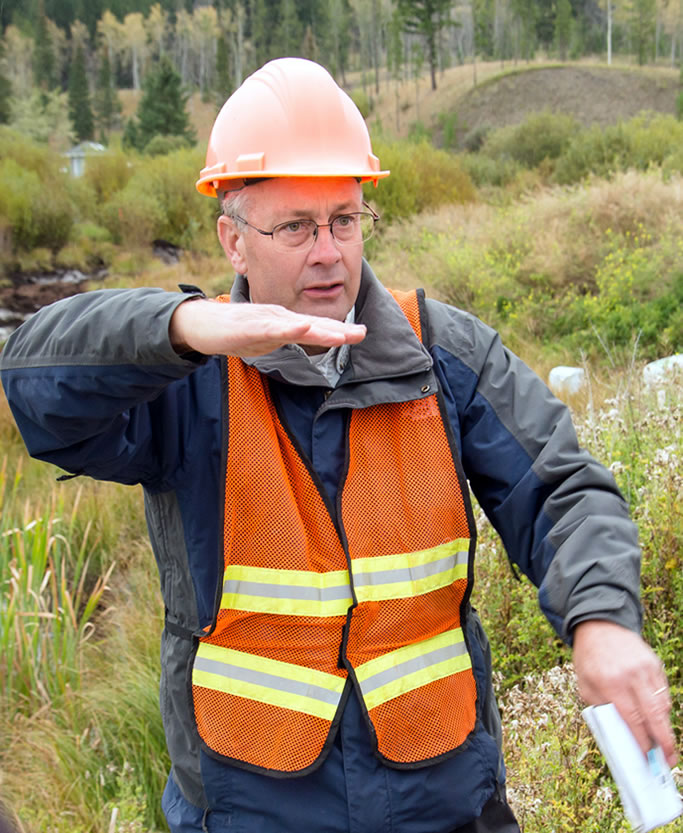 Tom Biebighauser, Wetland Restoration and Training
Tom Biebighauser, Wetland Restoration and Training
PowerPoint presentation is available here.
ABSTRACT
The main reason so many wetland projects are unsuccessful is that the builder has failed to disable historic drainage structures. People have been burying rock, wood, brick, clay, concrete, and plastic pipe in the ground to dry wetlands since Europeans began cultivating North America. This presentation will show you exactly how wetlands were drained and filled, and how you can spot the ghost of a wetland drained over 300-years ago.
BIOS
Tom Biebighauser has restored over 1,650 wetlands in 20-States and 2-Canadian Provinces. He has studied wetland drainage for over 30-years, working with senior contractors who spent their lives destroying wetlands. Tom teaches practical, hands-on workshops across North America where participants learn about wetland restoration by becoming involved in the design and construction of naturally appearing and functioning wetlands. He has written 3-books about wetland restoration, and instructs online college courses about how to restore wetlands. Please visit Wetland Restoration and Training for information about the techniques he is using, and courses that are available.
How Restoration Outcomes are Described, Judged and Explained
Held September 9, 2014 – 3:00 pm eastern
INTRODUCTION
- Marla Stelk, Policy Analyst, Association of State Wetland Managers [POWERPOINT PRESENTATION]
PRESENTERS
How Restoration Outcomes are Described, Judged and Explained – Contributors: Joy Zedler, Aldo Leopold Chair of Restoration Ecology, University of Wisconsin; Robin Lewis, Lewis Environmental Services, Inc. & Coastal Resource Group, Inc.; Richard Weber, NRCS Wetland Team, CNTSC; Bruce Pruitt, USACE Engineer Research & Development Center; Larry Urban, Montana Department of Transportation
PowerPoint presentation is available here.
BIOS
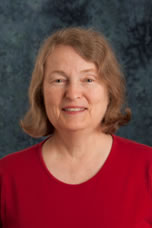 Joy Zedler is a Professor of Botany at the University of Wisconsin-Madison and the Aldo Leopold Professor of Restoration Ecology and Research Director at the Arboretum. Her research and writings concern wetlands, restoration, and conservation of biodiversity and ecosystem services; she promotes Adaptive Restoration, mentors students, and helps edit the journal, Restoration Ecology. She advises many organizations on environmental issues and restoration projects. She is a Fellow of the Society of Wetland Scientists and a Fellow of the Ecological Society of America, in recognition of her research and service.
Joy Zedler is a Professor of Botany at the University of Wisconsin-Madison and the Aldo Leopold Professor of Restoration Ecology and Research Director at the Arboretum. Her research and writings concern wetlands, restoration, and conservation of biodiversity and ecosystem services; she promotes Adaptive Restoration, mentors students, and helps edit the journal, Restoration Ecology. She advises many organizations on environmental issues and restoration projects. She is a Fellow of the Society of Wetland Scientists and a Fellow of the Ecological Society of America, in recognition of her research and service.
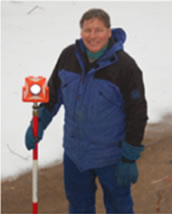 Bruce Pruitt, PhD, PH, PWS is a Research Ecologist with the Engineer Research and Development Center, Vicksburg, MS (USACE). He is a Professional Hydrologist and Wetland Scientist with over thirty cumulative years of professional level work experience in both private and public sectors. Bruce has lead studies related to ecology, hydrology, and water quality including sedimentology on a diversity of aquatic ecosystems including streams, wetlands, lakes, estuaries, and salt marshes. He has conducted intensive investigations and developed functional assessment models applicable to the Western Kentucky Coalfields, East Everglades, Sharks River Slough, and the Florida Keys. He received a Bronze Metal from USEPA for the wetland functional assessment model he developed and tested for the Florida Keys which is still in use today. Bruce has provided hydrogeomorphic design, construction oversight, and monitoring on several stream, wetland and salt marsh restoration projects. Bruce has also developed and published regional hydraulic rating curves for western Kentucky and the Piedmont of Georgia applicable to functional assessment and stream restoration. Since 1989, Bruce has served as an instructor in numerous applied training courses including federal wetland delineation, functional assessment, and fluvial geomorphology.
Bruce Pruitt, PhD, PH, PWS is a Research Ecologist with the Engineer Research and Development Center, Vicksburg, MS (USACE). He is a Professional Hydrologist and Wetland Scientist with over thirty cumulative years of professional level work experience in both private and public sectors. Bruce has lead studies related to ecology, hydrology, and water quality including sedimentology on a diversity of aquatic ecosystems including streams, wetlands, lakes, estuaries, and salt marshes. He has conducted intensive investigations and developed functional assessment models applicable to the Western Kentucky Coalfields, East Everglades, Sharks River Slough, and the Florida Keys. He received a Bronze Metal from USEPA for the wetland functional assessment model he developed and tested for the Florida Keys which is still in use today. Bruce has provided hydrogeomorphic design, construction oversight, and monitoring on several stream, wetland and salt marsh restoration projects. Bruce has also developed and published regional hydraulic rating curves for western Kentucky and the Piedmont of Georgia applicable to functional assessment and stream restoration. Since 1989, Bruce has served as an instructor in numerous applied training courses including federal wetland delineation, functional assessment, and fluvial geomorphology.
 Roy R. "Robin" Lewis, III is President of Lewis Environmental Services, Inc., and Coastal Resources Group, Inc., a not-for-profit scientific and educational organization, both with offices in Valrico, Florida, and Salt Springs, Florida. He is a Professional Wetland Scientist certified by the Society of Wetland Scientists, and a certified Senior Ecologist with the Ecological Society of America. He has forty years of experience in the design and construction of wetlands with over 200 completed and successful projects in the USA and overseas. He has recently designed, permitted, and supervised initial construction of a 400 ha mangrove restoration project at the Rookery Bay National Estuarine Research Reserve near Marco Island, and a 7,000 ha project in Indonesia. He has also worked and taught wetland restoration in twenty-two foreign countries including Jamaica, Bonaire, the Bahama Islands, Cuba, Costa Rica, Barbados, Guyana, Nigeria, Mexico, Puerto Rico, the US Virgin Islands, India, Sri Lanka, Thailand, Vietnam, Indonesia and Hong Kong. He specializes in the ecological monitoring, management and restoration of mangrove forests and seagrass meadows and has over 125 professional publications in these and other wetland subject areas.
Roy R. "Robin" Lewis, III is President of Lewis Environmental Services, Inc., and Coastal Resources Group, Inc., a not-for-profit scientific and educational organization, both with offices in Valrico, Florida, and Salt Springs, Florida. He is a Professional Wetland Scientist certified by the Society of Wetland Scientists, and a certified Senior Ecologist with the Ecological Society of America. He has forty years of experience in the design and construction of wetlands with over 200 completed and successful projects in the USA and overseas. He has recently designed, permitted, and supervised initial construction of a 400 ha mangrove restoration project at the Rookery Bay National Estuarine Research Reserve near Marco Island, and a 7,000 ha project in Indonesia. He has also worked and taught wetland restoration in twenty-two foreign countries including Jamaica, Bonaire, the Bahama Islands, Cuba, Costa Rica, Barbados, Guyana, Nigeria, Mexico, Puerto Rico, the US Virgin Islands, India, Sri Lanka, Thailand, Vietnam, Indonesia and Hong Kong. He specializes in the ecological monitoring, management and restoration of mangrove forests and seagrass meadows and has over 125 professional publications in these and other wetland subject areas.
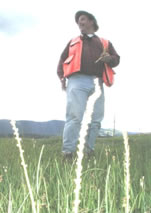 Lawrence J. “Larry”Urban is the wetland mitigation specialist for the Montana Department of Transportation with state-wide responsibilities based out of Helena, Montana. He has over 30 years of experience in wetland delineations, functional assessments, monitoring and mitigation site development for both the New Jersey and Montana Department of Transportations. He has been involved in the development of a comprehensive aquatic resource mitigation program to meet wetland and stream mitigation needs for transportation projects throughout the state of Montana that has created over 55 mitigation areas ranging in size from ½ to 300 acres in size. He developed an annual monitoring program for the purposes of managing aquatic resource mitigation sites on both private and state lands to comply with federal, state and Tribal permitting requirements. Assisted in the funding, development and continued oversight of the Montana Department of Transportation’s Montana Wetland Assessment Method (MWAM) originally developed in 1989. He has also presented at a number of National and regional wetland mitigation conferences, and participates in annual continuing education courses as an instructor in wetland regulations, mitigation and wetland assessments in the state of Montana.
Lawrence J. “Larry”Urban is the wetland mitigation specialist for the Montana Department of Transportation with state-wide responsibilities based out of Helena, Montana. He has over 30 years of experience in wetland delineations, functional assessments, monitoring and mitigation site development for both the New Jersey and Montana Department of Transportations. He has been involved in the development of a comprehensive aquatic resource mitigation program to meet wetland and stream mitigation needs for transportation projects throughout the state of Montana that has created over 55 mitigation areas ranging in size from ½ to 300 acres in size. He developed an annual monitoring program for the purposes of managing aquatic resource mitigation sites on both private and state lands to comply with federal, state and Tribal permitting requirements. Assisted in the funding, development and continued oversight of the Montana Department of Transportation’s Montana Wetland Assessment Method (MWAM) originally developed in 1989. He has also presented at a number of National and regional wetland mitigation conferences, and participates in annual continuing education courses as an instructor in wetland regulations, mitigation and wetland assessments in the state of Montana.
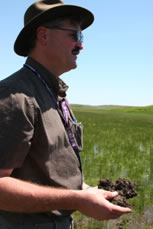 Richard A. Weber, P.E. is a Wetland Hydraulic Engineer with the USDA Natural Resources Conservation Service (NRCS), Wetland Team, CNTSC in Fort Worth, Texas from 2006 to present. In this role, Rich has provided national leadership on wetland hydrology, including: Support for Wetland Restoration Program, Wetland Protection Policy, and E.O. 11990 Wetland Assessments. He leads a national training cadre for Wetland Restoration and Enhancement and Hydrology Tools for Wetland Determination courses. From 2005-2006, Rich was Design Engineer at the NRCS Nebraska State Office where he had design and A&E Contracting responsibilities for PL-566, WRP, and EQIP programs. From 1999-2005, he was a Field Engineer at the NRCS in the Scottsbluff, NE Field Office where he had design, construction, and contracting responsibilities for the Wetland Reserve Program, EQIP Irrigation and Animal Waste Management, and CTA conservation practices. From 1997-1999, Rich was an Agricultural Engineer at the NRCS in Chehalis, WA where he had design, construction, and contracting responsibilities for Conservation District funded Stream Restoration and Fish Passage projects, and EQIP program Animal Waste Projects. And from 1986-1997, he was a Watershed Project Engineer at the NRCS in Horton, KS where he performed Construction Contract Administration for PL-566 Watershed Protection and Flood Prevention projects.
Richard A. Weber, P.E. is a Wetland Hydraulic Engineer with the USDA Natural Resources Conservation Service (NRCS), Wetland Team, CNTSC in Fort Worth, Texas from 2006 to present. In this role, Rich has provided national leadership on wetland hydrology, including: Support for Wetland Restoration Program, Wetland Protection Policy, and E.O. 11990 Wetland Assessments. He leads a national training cadre for Wetland Restoration and Enhancement and Hydrology Tools for Wetland Determination courses. From 2005-2006, Rich was Design Engineer at the NRCS Nebraska State Office where he had design and A&E Contracting responsibilities for PL-566, WRP, and EQIP programs. From 1999-2005, he was a Field Engineer at the NRCS in the Scottsbluff, NE Field Office where he had design, construction, and contracting responsibilities for the Wetland Reserve Program, EQIP Irrigation and Animal Waste Management, and CTA conservation practices. From 1997-1999, Rich was an Agricultural Engineer at the NRCS in Chehalis, WA where he had design, construction, and contracting responsibilities for Conservation District funded Stream Restoration and Fish Passage projects, and EQIP program Animal Waste Projects. And from 1986-1997, he was a Watershed Project Engineer at the NRCS in Horton, KS where he performed Construction Contract Administration for PL-566 Watershed Protection and Flood Prevention projects.
View Past Improving Wetland Restoration Success Webinars Here
| 2016 | 2015 | ||
View a List of Improving Wetland Restoration Success Webinar Recordings Here

